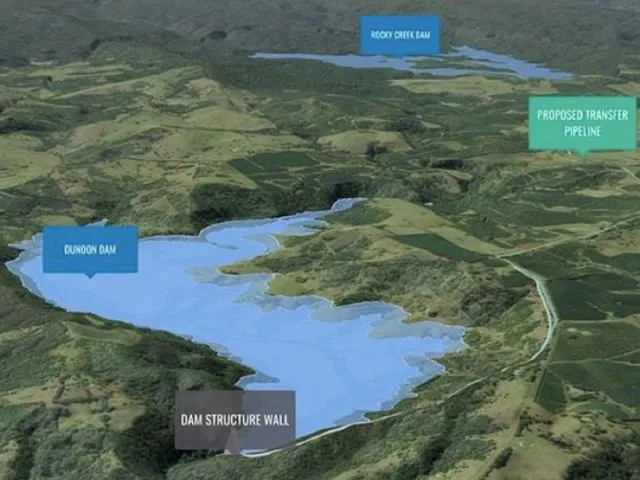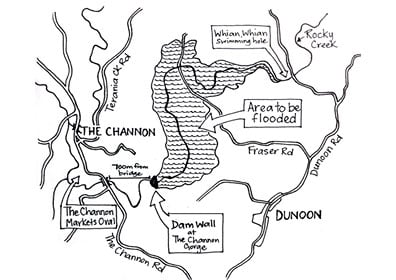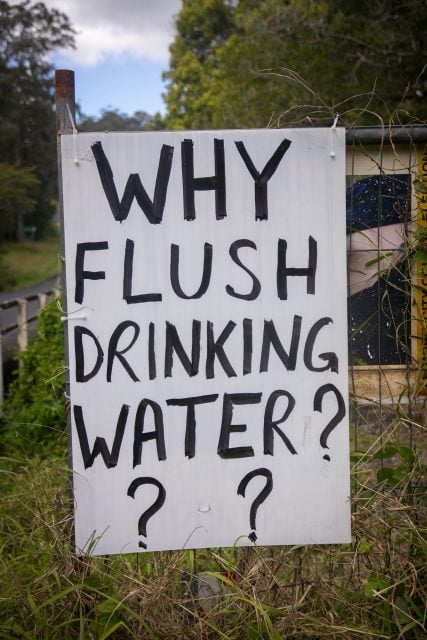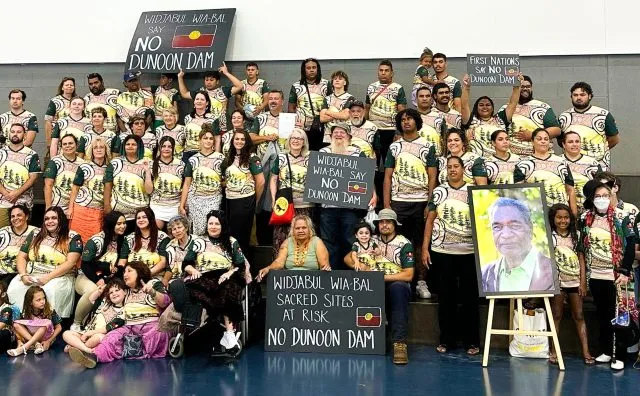
We have not heard much about the Dunoon Dam lately and many people are asking: ‘What is happening with that dam?’
The short answer is that Rous is definitely planning on building the Dunoon Dam as part of Stage 3 of its Future Water Project.
Six of the eight councillors on Rous are strongly in favour of the dam. They will decide whether it goes ahead. These same six councillors circulated a petition in 2021 which specifically discounted all permanent water supply options other than a new dam. Based on that petition they do not accept recycling (‘toilet to tap’ as they call it), or groundwater, or desalination plants.
Kerbside push-poll signatures for this petition were collected by asking: ‘do you want to drink toilet water or do you want a new dam?’ Rous incorrectly counted 1,000s of these signatures as valid submissions to its public consultation process for its revised Integrated Water Cycle Management Plan in 2021. (This was the plan which excluded the Dunoon Dam). The result was an apparent majority in favour of the dam.
Aside from this petition, all of the other submission processes since 2020 have yielded responses that have been overwhelmingly against the dam:
- Rous’ consultation on the Future Water Project in mid-2020: 98 per cent against the dam
- Dept Planning and Environment (DPE) consultation on the Draft Far North Coast Regional Water Strategy in late-2020: 95 per cent against the dam
- DPE consultation on the 2nd Draft Far North Coast Regional Water Strategy in 2022: 97 per cent against the dam
There is clearly a lack of social licence for the dam and a strong social movement against it.
The DPE released the final Far North Coast Regional Water Strategy in June 2023. The dam was not included in the short list of options. They took account of the strong community opposition, the ‘major to extreme’ environmental effects, and the lack of cost effectiveness of the dam.
Nevertheless, the DPE has not precluded Rous and the four LGAs (Lismore, Ballina, Byron and Richmond Valley) from going it alone in their pursuit of the dam. The dam could still be constructed by Rous, despite the evidence that the dam is not viable economically, socially, culturally, environmentally, or in the provision of drought or flood security.

For those who are new to this issue here are some of the reasons why this community and region do not need the Dunoon Dam.
Cost
The original $220 million cost of the dam is now estimated by DPE at $514m, or $841m if the service area were extended to include independent water supplies such as Nimbin and Mullumbimby. Dam construction costs habitually blow out by 50 per cent so this figure could be expected to rise.
This huge upfront cost would place a large financial burden on residents who would be paying water storage costs from day one without any benefit for forty years or more. With government funding unlikely, it would be financed primarily by current and future water users.
Rous has not provided an estimate of the effect of the dam on the price of bulk water to the local government areas (LGAs). A very rough calculation could be done by dividing $814 million by the 40,100 water connections but no doubt there would be other variables as well.

Water security
Dams don’t defeat drought, especially when global heating is already making extremes the new normal. Rainfall-dependent water sources in a drying climate are inherently insecure, as our state and federal governments are acutely aware.
The proposed 50GL dam would have 3.5 times the capacity of the existing 14GL Rocky Creek Dam upstream but has only half the catchment area. Rocky Creek Dam holds roughly one year’s supply of water. With four years of minimal rain and no wet season, both Rocky Creek and Dunoon dams could be empty. A full dam in a flood year is no security for a prolonged drought.
Droughts more than a decade long have been recorded in the past and will be more likely in the future. The high cost and the all-water-in-one-bucket approach of a new dam would impede other water strategies that show a higher cost/benefit ratio, i.e. they would cost a great deal less and provide real benefits.
Catastrophic events can occur, making a new dam a less safe option that the alternatives. Blue-green algae contamination already occurs at Clarrie Hall Dam and Emigrant Creek Dam. Increased heat and evaporation makes contamination events more likely.
Dam failure is not out of the question. In the 2022 flood, Rocky Creek Dam came so close to over-topping, and hence failing, that downstream residents were warned by text ‘Dam failure. Evacuate now’. If the earth-wall dam did fail and the released water hit a rolled-concrete wall a few kilometres downstream the results would be unthinkable. Such extreme weather events as we saw in 2022 are predicted to occur more frequently.
As for flood mitigation, over 1,000GL moved through Lismore in the 2022 flood. A 50GL dam upstream, even if completely empty at the start of the event, could do very little to reduce that volume.

Cultural effects
The Widjabul Wia-bal people of the Bundjalung nation have said repeatedly since the dam was first proposed in 1995 that they do not accept it. In 2011 senior knowledge holder, Uncle John Roberts, revealed to anthropologists the location of a burial ground and other significant evidence of Aboriginal occupation at the site (2011 Dunoon Dam Cultural Heritage Impact Assessment (CHIA)).
Two years later, this information was confirmed in the 2013 CHIA in which the eminent archaeologist, Dr Douglas Hobbs, stated that the burials were likely to be pre-European.
Rous has decided to impose yet another study on the Widjabul despite their resistance and their determination to follow Uncle John Roberts’ wishes of ‘No dam, No more studies’.
This site is Australian heritage; we must not lose it.

Environmental effects
The DPE’s Draft Strategy determination that the environmental effects would be ‘major to extreme’ deals just with the aquatic ecology.
The terrestrial effects would be even worse. The Dunoon Dam Terrestrial Ecology Impact Assessment of 2012 revealed that an Endangered Ecological Community of lowland subtropical rainforest would be destroyed by the construction of the dam. This rainforest on the western edge of the Big Scrub represents about six per cent of the remaining one per cent of the original Big Scrub.
72 ha of koala habitat would be drowned, cleared or fragmented. Koalas are now classed as endangered, mainly because of loss of habitat, which drives deaths from disease, car strike and dog attack. Three kilometres of platypus habitat in Rocky Creek would be lost – a big lake is not what platypus need.
Offsets
A new environmental study is to be done, insisted on by the pro-dam councillors. We can expect it will recommend offsets which will propose setting aside some non-alike vegetation to compensate for the destruction of the subtropical and warm temperate rainforest at the site. Rous has already proposed revegetating the weedy slopes at the site as an offset for the unique warm temperate rainforest on sandstone in The Channon Gorge.
The Indigenous and environmental issues both face considerable federal cultural and environmental heritage hurdles. These are effectively what stopped the dam in 2020, before it was put back on the table by populist politics.

The Dunoon Dam is being promoted primarily to cater for unsustainable growth of housing and tourism on the coastal strip. This should not be at the expense of our beautiful hinterland. Please keep informed and be prepared to continue defending this precious place.
For more information go to waternorthernrivers.org.
♦ Nan Nicholson is a member of WATER Northern Rivers, a group which is opposed to the proposed Dunoon Dam.




Wow !
Seeing the diagrams of this site, it occurs to me that this would be a perfect scenario for a pumped hydro facility, and could not only provide certainty of supply of clean drinking water, but a great local back-up for emergency electrical supply.
I wonder what the fall is from Rocky Creek Dam to the level of the new dam, being such a short distance it would facilitate the efficiency of a turbine and minimise the energy required to pump up to Rocky Creek and be a beautiful clean energy contribution to an alternative future.
Well spotted Nan, G”)
Hydroelectric power from the proposed Dunoon Dam has already been classified by Rous as non-viable
It’s hard to comprehend in this day and age, that flushing toilets are even still considered a viable option. Treating precious water as a waste-product and waste-disposal product is an absolute abomination. Sure, it was an improvement in its day over the former tin-can alley method and long-drop, but with correct composting methods, a valuable resource can be returned to the soil, keeping a whole heap of contaminants away from the environment at large.
Those who must use the archaic flush system should only be permitted to use on-site collected rainwater, and I would strongly recommend the same restrictions be applied to cleaning and car-washing. Using treated water needs to be phased out sooner rather than later.
Next step is to keep the damn animals out of the waterways. I envision a major big push coming real soon, both for employment and land regeneration, but more importantly for the sake of the Living Mother’s Waters, that a huge hemp revolution is overdue, whereby currently used cattle and crop land is given over both short and long-term to industrial hemp growth, which will pave the way to new beginnings to solve multiple crisis’.
First, combined with bamboo for poles, we can make canvas (literally Dutch for cannabis) for emergency tipi housing, free rent for the workers of this plan. Second is the hemp-crete to make bricks to start lining every waterway, which are to be opened up and natural habitat to be preserved wherever possible, as each is “walled off” to livestock using a step-method: small wide gradual steps on the water-side, steep narrow steps on the stock side, keeping the animals from fouling the water, and preventing drownings. The idea being the shallow wide steps will retain silt, providing plant habitat and fisheries, room for wading birds, and each level adjusts with the seasons, so even with heavy rainfall there’s always shallow edges to expand, hold, and make safe, every creek and stream. With adequate wide pools at the select locations for all livestock watering requirements.
This will further aid to keep all out waterways pure, encouraging a thriving aquatic industry and associated aquaculture taking advantage of abundant water for food and recreation. Further, as new steps are added every crop onto the land, the land will actually grow higher, as opposed to being flushed out to sea, and the streams themselves will slowly grow into major waterways. Banning all motor-driven vessels on the new system, sailboats and the like will become new uncongested transport options, floods will become a thing of the past, and drought can be managed more successfully.
On an even more grander scale, in more arid regions, I envision the construction of huge glass domes, where sea-water can be dredged into them, saving us from disastrous (lol) sea-level rising. Large shallow flats will rapidly evaporate this water to be collected by the ceiling, channelled down the sides, collected as pure distilled water. The resultant salt can be packaged for human consumption, used for stock and fertiliser needs, and to assist with replenishing minerals further upstream, as virtually all fish thrive in some amount of brine, which is antiseptic and valuable for aquatic plants.
These are just a few key steps I’ve been envisioning for many years. It can start small and grow everywhere. The value of the hemp crop cannot be underestimated, as bio-fuel, healthy oil, multiple industrial uses, a major competitor to unstable toxic cotton, paper, and 1,001 other things. It’s time we started action. We don’t need dams, we need a major change in the way we do everything, starting with the push of the first morning button.
More than half the palatable water collected in this country is used to make products exported to other countries. There are many times more water available that would be suitable for sanitation.
Of course the Dunoon dam is going to go ahead, Ballina Mayor Sharon Cadwallader promised to get it built so us Ballina residents would not have to drink “toilet water”, at the last LG elections, surely Sharon would not have made that promise just to get elected?
According to the published works schedule Rous should be starting work on constructing the Alstonville and Woodburn groundwater schemes next year (2024), however after 30+ years of studies, Rous just decided to spend another $8m to do more studies to decide the water augmentations they need. Probably a good idea given the appalling errors in the last study they did, but this latest move will delay any real decision until after the next Council elections.
The elected Rous Council (not just the current Council, but all of them for the last 30years) are just not qualified to make a decision, and they know it, so they do nothing, or if forced by circumstance to do something (e.g. the mismanagement of the water supply in the early 2000’s that caused Rocky Creek Dam to drop below 30%) the Council will waste close to a hundred million dollars on a scheme that doesn’t work (e.g. Wilsons River scheme).
The current Council are another “do nothing” Council and seem happy to just do spend $8m for more studies and defer a decision until after the election when they may not be there.
While this is happening, Rous are just burning more and more money, and people’s rates continue to rise. I suppose $8m in studies that will be as useless as the last studies they did is better than $100m+ on building assets that will be as useless as the last $100m in infrastructure they built (and are still paying off the loans for the construction work) that doesn’t supply anywhere near the water they claimed it would (Wilson River Scheme).
Excellent reporting by the Echo.
A must read article for everyone to debunk the misinformation & disinformation going around.
There is clearly a lack of social licence for a dam and a strong social movement against it, as points 1-3 below demonstrate.
Rous’ consultation on the Future Water Project in mid-2020: 98 per cent against the dam
Dept Planning and Environment (DPE) consultation on the Draft Far North Coast Regional Water Strategy in late-2020: 95 per cent against the dam
DPE consultation on the 2nd Draft Far North Coast Regional Water Strategy in 2022: 97 per cent against the dam.